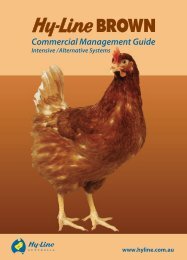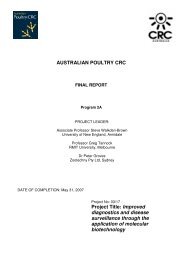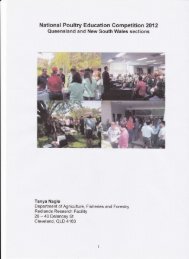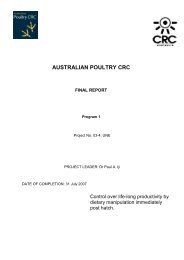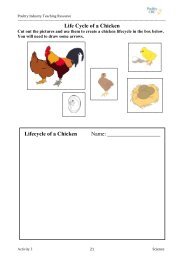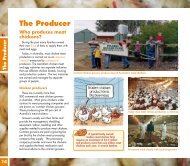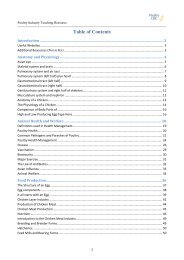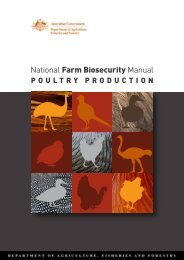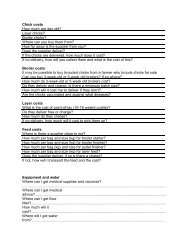AUSTRALIAN POULTRY CRC - Poultry Hub
AUSTRALIAN POULTRY CRC - Poultry Hub
AUSTRALIAN POULTRY CRC - Poultry Hub
- No tags were found...
You also want an ePaper? Increase the reach of your titles
YUMPU automatically turns print PDFs into web optimized ePapers that Google loves.
ManagementThis includes factors such as diet, strain, rearing, light levels and social pressure arising from type offeeders, drinkers and nest boxes.DietFeed intake is influenced by housing system, with birds on the floor, particularly free-range,consuming more feed than birds in cages. This increase is presumably in response to a greaterrequirement for energy resulting from increased activity and lower temperatures generally prevailingin non-cage environments. If birds do not achieve sufficient feed intake their bodyweight will be low.In commercial barn systems, mortality was markedly increased in flocks that did not reach theappropriate body weights at 26-29 weeks of age (Parkinson and Cransberg, 2002). The authors foundthat as the body weight of the pullets increased, egg production and mortality decreased. Diagnosticstudies of the underweight flocks indicated problems with egg peritonitis and salpingitis (Parkinsonand Cransberg, 2002). A change in diet can also cause problems in free-range systems. A new diet cancause reduced or increased palatability of the food and therefore result in decreased intake or increasedcompetition for food, leading to stress and frustration, which are reported risk factors in vent andfeather pecking (Pötzsch et al., 2001). A new diet may also cause diarrhoea, leading to an inflamedand reddened vent and soiled areas around the vent; these may attract pecking from flock mates.StrainWithin a given management system, strain of bird is an important factor affecting husbandryrequirements and economic performance. This is especially true in alternative systems with their morediversified environments and a correspondingly wider range of opportunities to exhibit behaviours notshown in cages. A wide selection of strains is now available and many producers believe that some ofthese are more suitable than others for free-range egg production under Australian conditions. Strainsmay differ in behavioural traits such as feather pecking, foraging activity, flightiness, broodiness andinclination to lay in nest boxes. These differences have repercussions both for the welfare of the birdsand the manageability of the system. Propensity for cannibalism is especially important as beaktrimming is prohibited in some accreditation schemes for free-range production.Drinker typeFlocks with hanging bell drinkers are more at risk of vent pecking and feather pecking than flocksprovided with water via other systems (Pötzsch et al., 2001). Bell drinkers provide a focus forcrowding and competition and consequently increase the level of stress. They are usually located nearnest boxes where activity, „tension‟ and severe feather pecking are more frequent that in other parts ofthe hen house (Nicol et al., 1999).RearingIt has been suggested that pullets should be reared in a system identical to that they are to be housed induring the production period. Access to perches from no later than 4 weeks of age decreases both theprevalence of floor eggs during the early production period and the prevalence of cloacal cannibalismduring the whole production period (Gunnarsson et al., 1999).Light LevelsLow light intensity in the hen house is frequently used to control vent and feather pecking. Illuminatednest boxes are generally screened with curtains to provide a sharp light-gradient from the outside to theinside of the nest boxes (Pötzsch et al., 2001). The change in light intensity experienced on entering anilluminated communal nest box may increase the visual attractiveness of the cloacal mucosa of a henthat has just laid an egg. Pötzsch et al. (2001) found that the use of light to encourage the use of nestboxes in comparison with no nest box light showed the strongest (positive) association with vent5



